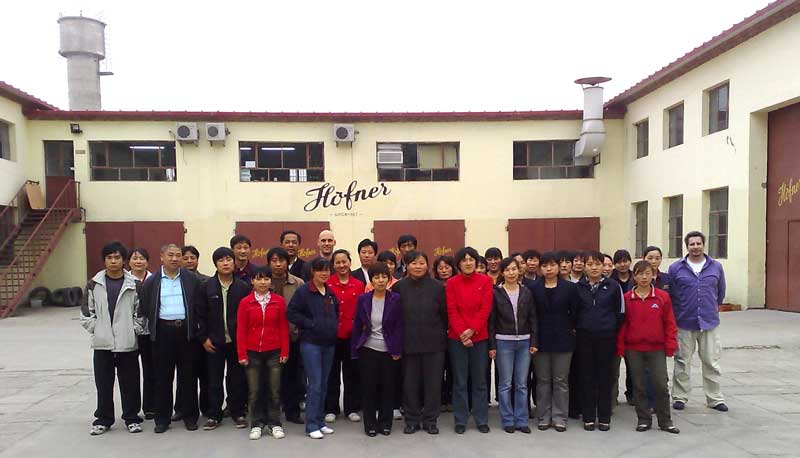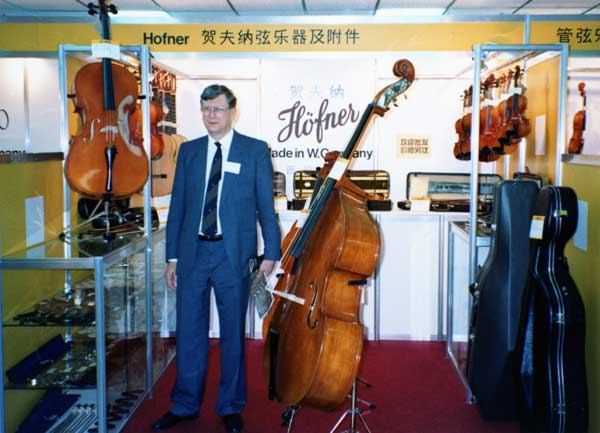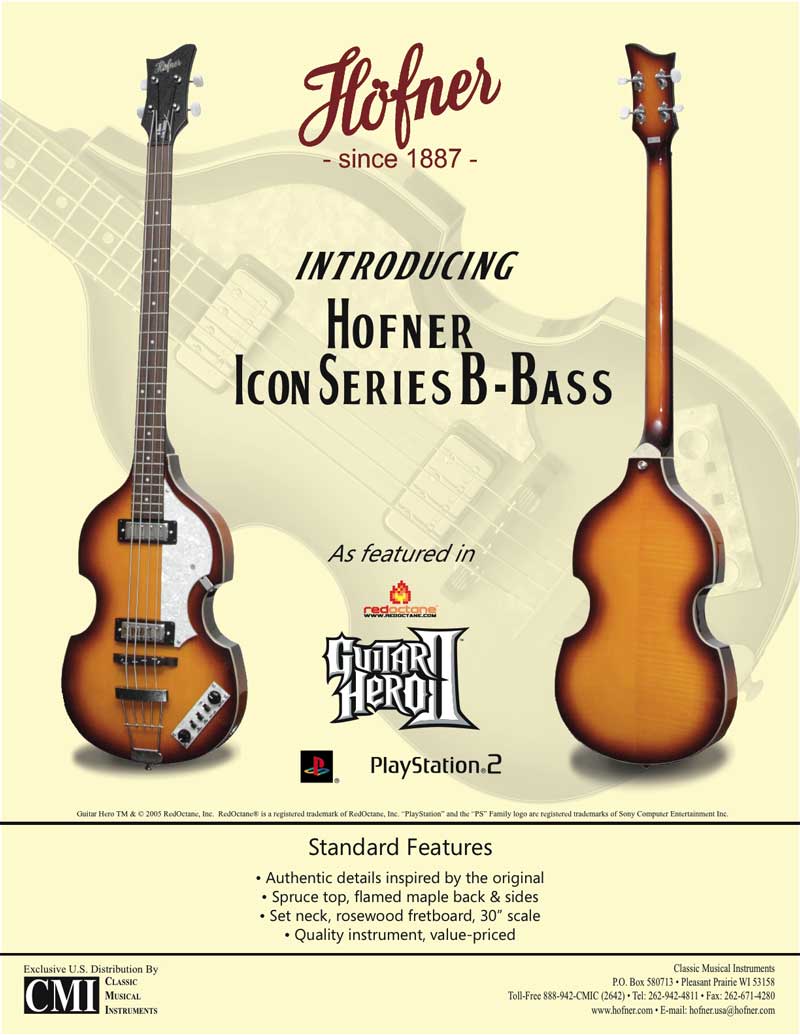

Hӧfner developed a working relationship with the Chinese
from a much earlier date than other Western instrument manufacturers. Christian
Benker had realised back in the 1970’s that there was tremendous economic
potential for the production of labour-intensive goods in China. He understood
even back then that China would soon become one of the World’s dominant
manufacturing countries, and that sooner or later Höfner would have to face up
to the fact that Chinese craftsmen were more than capable of producing stringed
orchestral instruments that would be in serious competition with Höfner, not
just in Asia but also throughout the World. It was significant that in 1982, a
high-powered Chinese trade mission visited Bubenreuth to look around the Höfner
workshops. In turn, Christian lead a German Instrument Manufacturers delegation
to the 1988 “Music China 88” trade fair in Canton, China in an attempt to
promote German instruments over there and hopefully open up a new market. Höfner
had for many years a very successful and loyal distributor of their products in
the form of the Tom Lee Piano Co. in Hong Kong, but really in order to tap into
the massive potential of China, a full-blown operation including a manufacturing
facility on the mainland of China would be required. Setting up such an
operation would need a lot of money.

One advantage of Höfner being
taken over by Boosey & Hawkes was that the resources of that large organisation
became available. Hӧfner was therefore finally able to open their office in
Beijing in the year 2000, followed by a manufacturing facility during 2001 in
order to produce the “Sienna” range of flattop acoustic guitars and classical
concert guitars, together with budget-level orchestral instruments.
Solid guitars followed in 2005, namely two
different versions of a new “Colorama” model and also a re-issue of the 1980’s
“Shorty” travel guitar. The quality of workmanship and especially the much lower
labour costs in China had finally become available to Hӧfner, and there was now
a way in which genuine Hӧfner products could be made available to far more
players.
With the management buy-out by the Schöller family at
the end of 2004, the Chinese subsidiary was seen as a major asset to the
Company, and it was decided to increase its scope still further. This was to be
achieved by using the facilities in China in order to produce a range of solid
guitars that comprised of a re-issue “Shorty” travel guitar and a basic solid
guitar inspired by a famous predecessor, the “Colorama”. These proved very
successful and this encouraged the company to consider introducing further more
complex models.
During the first decade of the new century, world
economic events began to be felt by Hӧfner. Germany adopted the Euro form of
currency in January 2002, at a time when the US dollar was comparatively strong
in the world. At that time, the exchange rate was less than 0.9 dollars per
Euro.
By January 2005 however, the Euro had gained strength
and the Dollar had weakened. Now 1.35 dollars were required to buy a Euro’s
worth of goods from Germany. The trend continued for the rest of the decade,
with an exchange rate of nearly 1.6 Dollars per Euro in 2008.
This situation had a devastating effect on Hӧfner’s
exports to the United States. The cost of what had been a US$ 2,999 German
guitar at the start of the decade had reached almost US$ 6,000 by 2008! Sales of
Hӧfner’s expensive top-line archtops in the US began to plummet. They could
never hope to be competitive against the home-grown American and particularly
the Asian-made
instruments.
Graham Stockley, joined the
company in 2005 after many years'
involvement with Hӧfner in the role of UK-distributer and also since 1999 as a
member of the multi-national design team referred to in previous chapters.
Graham immediately became heavily engaged in the development of new models to be
produced in China.
It had been decided that the Verythin, Club,
and Violin Bass models would be suitable for the new Chinese-made “Contemporary”
range, (abbreviated to “CT”), and Graham launched himself into the setting up of
the necessary training, and development work in China together with the actual
detailed design of the new CT models. The existing moulds and jigs in the
Hagenau workshops were copied and new equipment was set up in China. Höfner even
instituted a period of training for the Chinese luthiers in Hagenau in order to
provide them with first-hand experience in guitar manufacture, German-style.
The basic idea behind this project was to produce genuine Hӧfner guitars that would sell at a considerably lower price level than their German-made equivalents, hence opening up the market for instruments that would be more accessible to younger players and also of such a quality that they could also be used by professional players who wished to save the inevitable “life on the road” wear and tear on their high-value guitars. This two-range policy is now adopted by most of the large US Guitar makers.
By September 2006, Höfner CT Verythin guitars, as well
as CT 500/1 bass guitars, started leaving China.
Over the years since 2005, several different versions of
the CT Verythin have been produced with many different finishes on offer, and a
growing number of these have been “Limited Editions”. This has been possible due
to the comparatively high sales levels of these popular guitars, together with
the high degree of adaptability demonstrated by the Asian craftsmen. However,
all have been based on the one formula which has been developed from the
German-made Verythin Standard model of 2002 to 2008:
Initially, the CT Verythin was
available with the option of antique brown sunburst, transparent red, or solid
black polyurethane finishes, although since then many other finishes have been
applied.
From 2010 onwards, the simple clay dot fret-markers were
replaced by the traditional Verithin “strip-type”. By 2015, the “bell-flower”
headstock design had been changed to the simpler Hӧfner “dagger” inlay. Also,
single coil “P90-style” pickups became available on the CT Verythin for the
first time.
In 2009, a three-pickup version was added to the CT
range. Called simply the “CT Verythin 3”, this guitar was basically the same as
the CT Verithin apart from the following:
The Verythin 3 was produced up to the end of 2012, at
which time its place was taken by yet a new model called the “CT Verythin
Deluxe”. This model reverted back to the same general specification as the CT
Verythin, but had a scaled-down body and a very classy transparent black finish
which combined with the flamed timbers of the body lead to an instrument whose
looks and overall quality were far in excess of what one should expect from a
guitar having such a modest retail price.
A shorter-lived CT version of
the old Club-style guitars was also launched during 2006 in parallel with the CT
Verythin. Like the CT Verythin, this guitar successfully impersonated the
concept and looks of the original 1950’s/60’s guitars, but with a price tag and
performance more appropriate for
amateur and semi-professional players of the 21st
century.
The old Clubs had small, fully-hollow bodies, but no
sound holes of course. The new CT version looked very much the same, but it
actually had a central sustain block inside the body, just as the CT Verythin.
Other than that feature, the new CT Club looked very similar indeed to the old
Club 50/126 model. The trapeze tailpiece, the wooden bridge with fretwire
saddles, and the suspended pickguard were all there, together with a rosewood
fingerboard with clay dots, the bell-flower headstock decoration, and simple
body binding to the body and neck edges. There were even two German
Schaller-made Type 510 “Diamond Logo” pickups controlled by the traditional Hӧfner
rectangular control console.
The same three finishes as offered on the CT Verythin
were available, and with the antique brown sunburst specified, the guitar could
almost be believed to have just arrived direct from 1962!
The old Club-style guitars have always had something of
a reputation as being the poor-man’s Les Paul, with which they share similar
dimensions and overall appearance. This must have been very much in Graham
Stockley’s mind when he brought out a Gold-Topped version of the CT Club in
2009. As well as the rather pleasing gold-sprayed body top, the rest of this
guitar was given a dark brown polyurethane finish which gave a hint of mahogany,
although the maple flame laminated body timbers could still be seen. The
electrics provided were two single coil black-bar pickups controlled by single
volume and tone controls plus a tree-way selector. All-in all, the cosmetics of
the guitar, including the strip-type fret markers, matched those given to the
also brand new CT Verythin 3 model…….apart from the gold top of course!
Both the above CT Club models were dropped from the
catalogue by the end of 2011. In the previous year, a solid version of the Club
had been introduced which looked and certainly sounded much more like the Les
Paul, and the sales figures made it very clear as to which version Hofner should
proceed with.
Hӧfner have always been archtop guitar makers since the
1930's, and up to recent times many of their archtop models had been aimed at
the budget and mid-price range level of the market. However, with the current
German range now concentrating purely on high quality guitars, there was a
definite need for the return of some lower-priced archtop models in order to
plug the gap.
A Korean-made Hӧfner 17” bodied archtop first appeared
at the 2007 NAMM Trade Show in California. This guitar, which appears to have
been supplied directly into the United States, was designated the Hӧfner
H-5 and it certainly ticked all the right boxes. Being a $700 guitar, it had of
course a laminated spruce top with laminated flame maple for its body back and
3½” deep rims, but everything about the guitar was high quality. Made to Hӧfner’s
own specification and design in the old Epiphone factory in Korea just before it
was closed down, the people who put it together had certainly had plenty of
previous practice. This guitar quickly received excellent reviews from the
pundits for its sound and build quality, provided at a fraction of the cost of
the German-made archtops.
Details taken from the
German-made range included bound ebony fingerboard, ebony tailpiece, pickguard
and bridge, together with bound soundholes, plenty of line purfling around the
body, and the traditional Hӧfner “bell-flower” headstock decoration. There
appear to be examples fitted with either body-mounted single pickups or
neck-mounted floating pickups. Finishes
available were cherry, translucent brunette, and a small number of natural
blondes. Around 450 of this model were produced, and examples were still
available for sale up to around 2009.
With the Korean factory closed down by the time that the supply of H-5’s had run out, Hӧfner needed a re-think, and what was more obvious than to build an H5 replacement into their expanding CT range from China. So, in 2010 the CT-J17 range was introduced. These large 17” cello guitars were offered in three styles:
J17 Archtop without body cutaway, fitted with single body-mounted humbucking pickup. Antique Brown sunburst finish only. Chrome plated Lyre-style tailpiece and micromatic-style bridge.
J17 Archtop guitar with cutaway and fitted with single floating pickup attached to the end of the fingerboard. Available in either natural or Antique Brown sunburst. Ebony scratchplate, bridge, and tailpiece.
J17 Archtop guitar with
cutaway, fitted with two humbucking pickups mounted directly onto the body top
together with conventional controls. Chrome
plated Lyre-style tailpiece and micromatic-style bridge.
These guitars were of conventional appearance, with fully-bound body and fingerboard. The Hӧfner traditional bell-flower design was prominent on the headstock, and the laminated maple body had a laminated spruce table. At a retail price of approximately 600 Euros, these guitars continued the H-5 tradition of offered excellent value for money.
The non-cutaway version was deleted from the range in 2013, whilst at the same time, the two cutaway models were re-named first the “Blue Tone" Archtops, and later "Superluxe". They were still in the Hofner catalogue of 2019.
In order to give a full account of Hӧfner’s involvement
in Asia, the following is an explanation of Hӧfner’s third guitar brand. This
has to date been applied mainly to bass guitars.
The
“Hӧfner
Icon” brand originated from around the same time as Hӧfner had commenced
production of solid electric guitars in China in 2005, and arose from a desire
by Höfner’s distributor in the United States, Classic Musical Instruments (or
CMI), for a very low-cost bass that would have a similar appearance, sound, and
feel to that of the original Hofner Violin bass guitar, but which could
compromise slightly on matters of detail. Rob Olsen, who was by then working for
CMI, explains the philosophy:
“Yes, we had a target price of
under $399 in order to take on the many copies made by other manufacturers of Hӧfner basses which were
selling in tens of thousands at that time throughout the US. We thought...why
not take these away? Several large dealers told us that they would stop buying
copies if Hӧfner made a good copy themselves!”

CMI's 2006 Advertisement which introduced the Icon Bass.
The Höfner Icon Series B-Bass
was introduced in 2006 and being a US-lead initiative was intended to sell
mainly in the US and Canadian markets. However, the internet ensured that this
model was sold to players all around the World.
All components were sourced from Asia, with
CMI themselves supervising construction and quality control. Rob Olsen had spent
considerable time and effort researching the project before production, in order
to arrive at the best design which balanced cost, market, production problems,
etc. Even when the design was fixed, Rob spent a great deal of time in China
where the basses were made for the first two years, and in Indonesia where production was then moved to. All his efforts
were rewarded however, and the bass proved to be
a great success.
From 2010, the Icon Bass was taken under Höfner’s full control from Germany and given the new brand name of “Ignition Bass”. This name change was necessary due to another German manufacturer using the “Icon” brand name. During 2012/13, "Cavern" and "Club" variations on the theme were introduced under the "Ignition" label.
2012 Hӧfner Ignition Club Bass Guitar.
To date, no archtop or thinline
archtop model has been produced under the “Icon” or “Ignition” labels, although
a handful of prototype Icon HI-459 “Violin Guitars” were produced at one stage.
__________________________________________________
All Text is Copyright
© 2022 Steve Russell. All Rights Reserved